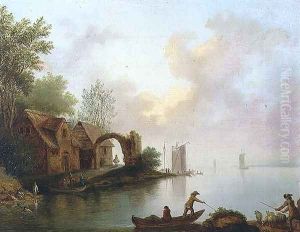Johann Heinrich Wust Paintings
Johann Heinrich Wüst was a Swiss artist known for his work as a landscape painter, watercolorist, and engraver. Born on November 12, 1741, in Zürich, Switzerland, he grew up in an era when the art scene in Europe was transitioning, with the influences of Rococo giving way to Neoclassicism. Wüst's work reflects elements of both of these artistic movements, though he is not as widely recognized as some of his contemporaries.
In his early years, Wüst received his artistic training in Zürich, where he was influenced by the Swiss landscape and the burgeoning appreciation for natural beauty. He initially worked as an engraver, a profession that required meticulous attention to detail and honed his skills in capturing intricate designs. This skill would later influence his detailed landscape paintings.
As a landscape painter, Wüst contributed to the genre with a focus on Swiss scenery. He was part of a tradition of artists who celebrated the pastoral and Alpine landscapes of Switzerland, which were becoming increasingly popular as travel within Europe grew during the 18th century. His works included both oil paintings and watercolors, with watercolor becoming an increasingly popular medium during his lifetime due to its convenience for outdoor painting and the growing trend of Romanticism, which favored the spontaneity and translucency that watercolors could provide.
Wüst's engravings and landscapes were appreciated for their detailed representation of nature and the Swiss environment. However, he did not achieve the same level of fame as some of his contemporaries, and as a result, his works are less well-known in the broader context of European art history. Despite this, his art provides valuable insights into the Swiss artistic landscape of the time and contributes to the understanding of the period's aesthetic values.
Johann Heinrich Wüst's career spanned several decades, during which he witnessed and adapted to changing tastes in art. He continued to work until his later years, contributing to the visual documentation of the Swiss landscape. Wüst passed away on January 21, 1821, in Zürich, leaving behind a body of work that, while not widely celebrated, remains a part of the Swiss artistic heritage and offers a glimpse into the landscape and sensibilities of 18th and early 19th-century Switzerland.
